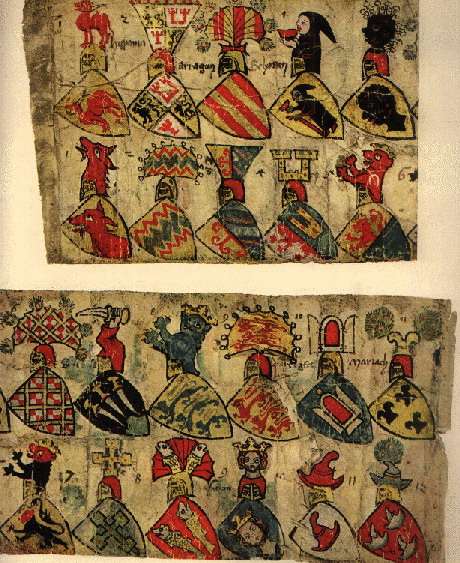Zürich armorial on:
[Wikipedia]
[Google]
[Amazon]
 The Zurich armorial (German: ''Zürcher Wappenrolle'') is a
The Zurich armorial (German: ''Zürcher Wappenrolle'') is a
Digitalized
at e-codices
 The Zurich armorial (German: ''Zürcher Wappenrolle'') is a
The Zurich armorial (German: ''Zürcher Wappenrolle'') is a roll of arms
A roll of arms (or armorial) is a collection of coats of arms, usually consisting of rows of painted pictures of shields, each shield accompanied by the name of the person bearing the arms.
The oldest extant armorials date to the mid-13th centur ...
made in c. 1340 presumably in what is now eastern Switzerland
). Swiss law does not designate a ''capital'' as such, but the federal parliament and government are installed in Bern, while other federal institutions, such as the federal courts, are in other cities (Bellinzona, Lausanne, Luzern, Neuchâtel ...
(in or nearby of what is now the canton of St Gallen
The canton of St. Gallen, also canton of St Gall (german: link=no, Kanton St. Gallen ; rm, Chantun Son Gagl; french: Canton de Saint-Gall; it, Canton San Gallo), is a canton of Switzerland. The capital is St. Gallen.
Located in northeastern ...
); it is now kept in the Swiss National Museum
The Swiss National Museum (german: Landesmuseum)—part of the ''Musée Suisse Group'', itself affiliated with the Federal Office of Culture, is located in the city of Zurich, Switzerland's largest city, next to the Hauptbahnhof.
The museum bu ...
in Zurich.
The document was owned by Zurich naturalist and historian Johann Jakob Scheuchzer
Johann Jakob Scheuchzer (2 August 1672 – 23 June 1733) was a Swiss scholar born at Zürich.
Herbarium deluvianum
Zürich, Zwingli-Platz ( Grossmünster) : Former home of Konrad von Mure († 1280) and the house, where Johann Jakob Scheuch ...
(1672–1733). Its previous history is unknown. It was given to the Zurich city library by Scheuchzer's nephew in 1750.
The Zurich armorial is one of the oldest and most important surviving collection of arms of the lower nobility of the Holy Roman Empire
The Holy Roman Empire was a political entity in Western, Central, and Southern Europe that developed during the Early Middle Ages and continued until its dissolution in 1806 during the Napoleonic Wars.
From the accession of Otto I in 962 unt ...
. Its geographical focus is that of greater Swabia
Swabia ; german: Schwaben , colloquially ''Schwabenland'' or ''Ländle''; archaic English also Suabia or Svebia is a cultural, historic and linguistic region in southwestern Germany.
The name is ultimately derived from the medieval Duchy of ...
, including the Lake Constance
Lake Constance (german: Bodensee, ) refers to three bodies of water on the Rhine at the northern foot of the Alps: Upper Lake Constance (''Obersee''), Lower Lake Constance (''Untersee''), and a connecting stretch of the Rhine, called the Lak ...
area, German-speaking Switzerland
The German-speaking part of Switzerland (german: Deutschschweiz, french: Suisse alémanique, it, Svizzera tedesca, rm, Svizra tudestga) comprises about 65 percent of Switzerland (North Western Switzerland, Eastern Switzerland, Central Switz ...
, Elsass
Alsace (, ; ; Low Alemannic German/ gsw-FR, Elsàss ; german: Elsass ; la, Alsatia) is a cultural region and a territorial collectivity in eastern France, on the west bank of the upper Rhine next to Germany and Switzerland. In 2020, it ha ...
, and Baden
Baden (; ) is a historical territory in South Germany, in earlier times on both sides of the Upper Rhine but since the Napoleonic Wars only East of the Rhine.
History
The margraves of Baden originated from the House of Zähringen. Baden i ...
.
It consisted of four parchment strips each of a width of 12.5 cm and a combined length of four meters. One of the four parts was lost; on the surviving three parchment strips, a total of 559 coats of arms and 28 flags of bishoprics are depicted. A further 108 coats of arms depicted on the lost portion survive in manuscript copies, including one in the library of the counts of Königsegg-Aulendorf
Königsegg-Aulendorf was a county of southeastern Baden-Württemberg, Germany. It was created in 1622 as a baronial partition of the Barony of Königsegg, and it was raised to a county in 1629.
By 1806, the territories of Königsegg-Aulendorf ...
and one made by Hans Conrad Bernhauser (1698–1761) kept in Zurich Central Library.
References
* * facsimile edition by Heinrich Runge (1860)Digitalized
at e-codices
See also
* Heraldry of the Holy Roman Empire {{DEFAULTSORT:Zurich armorial Rolls of arms Heraldry of the Holy Roman Empire Medieval Switzerland 14th-century manuscripts Illuminated heraldic manuscripts